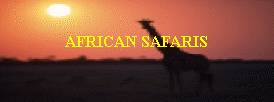
NOTE: "HOME" takes you to our initial web page; "UP" will return you to the Africa site for more exploring.
Our primary interest on this first trip to Botswana was to visit the Okavango Delta. We decided to travel to a Camp Okavango, accessible only via small aircraft, located in the heart of the Delta.
The
Okavango Delta, the largest inland delta in the world, covers over 60,000 square
miles of crystal clear water, wooded islands, grass-covered floodplains and vast
reed and papyrus beds, and is in itself a unique and fascinating ecosystem.
Instead of finding its way to the ocean as most rivers do, the Okavango
River, which originates in the Angolan highlands, fans out into a vast system of
thousands of waterways, separated by countless islands, to eventually disappear
into the Kalahari sands.
Many people, however, visit the Delta to observe its birdlife, as more than 400 species have been recorded here. Some species you may see are the wattled crane, Pel's fishing owl, slaty egret, Hartlaub's babbler, chirping cisticola and the coppery-tailed coucal. Fish eagles are common and there are also 16 species of herons, egrets and bitterns.